Foraging Mallow – Hiding in Plain Sight
April 04, 2010 | Updated April 22, 2021
As an Amazon Associate I earn from qualifying purchases.
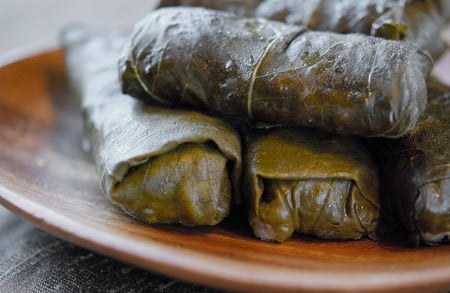
One of the fascinating things about the natural world is that no matter how knowledgeable you think you are, what you don’t know will always far outweigh what you do. An offhanded comment by my friend Josh recently about “foraging mallow” was a telling example of this.
When Josh said this, I played it off like “oh yeah, I know.” But while I knew that mallow was edible, and I was kinda sure it was what I grew up calling cheeses (the seeds look like little wheels of cheese) this was the sum total of my mallow knowledge.
Little did I know that the Eastern Mediterranean — Greece, Turkey, Syria, Israel, Egypt — loves this plant. Mallows are mostly a stewing green, as the leaves are a little fuzzy, which can be off-putting if you eat them raw in a salad (but hey, if you like eating fuzzy leaves, knock yourself out). Incidentally, the best source for mallow recipes, as well as a host of other unusual Mediterranean green things, is Paula Wolfert’s Mediterranean Grains and Greens.
As I did more research, I found that in Morocco, they cook the hell out of mallow and other greens to make a green sludge (Chez Panisse apparently made it once, calling it “herb jam.” Gotta love marketing!) that is spread hot on crusty bread. Saveur has a version of this recipe.
In the Piedmont region of Italy, it is chopped and added to that pan-European dish, the pureed green thing-potato-onion soup. I’ve seen scores of versions of this sort of soup, often with nettles. Here is my version, which uses borage.
Mallow also is part of the Cretan horta mix, which are random green things stewed with lots of olive oil and served with salt, pepper and lemon. It is cooked similarly in Egypt and in the Levant. It is in Turkey, however, where mallow comes into its own. My friend Fethiye, said Turks cook mallow like spinach, with sauteed onions, ground meat and chopped carrots. Some cooks add tomato. “When cooked,” she says, “Serve with yogurt — just like most any other cooked green dishes.”
Several other Turks said they use large mallow leaves as wrappers for dolma, which the Greeks call dolmades, most of us call stuffed grape leaves and which I call massively addicting. I’ve eaten whole cans at one sitting.
So I set out looking for these mallow plants, because I love me some dolma. As I typically do, I started by looking in my backyard, where I found a bunch of mallows growing — but they are the variety with smallish leaves; these are best for a mixed green saute or stew. What I wanted was the gigantic mallow leaves I’d heard were used to make dolmas in Turkey.
Josh wanted to go foraging for them, too, and we immediately decided this would be the easiest foraging trip ever. For those of you who live in Sacramento, you will know why: It grows EVERYWHERE along Highway 50. Giant, four-foot monsters with huge wide leaves.
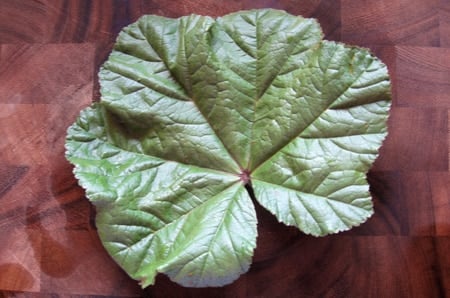
So Holly, Josh and I set out in search of mallow. We came up empty. Damn. So we got onto Highway 50 and debated. Do we really want to pick mallow alongside a highway? Pesticides are an issue, but there is enough mallow growing far back from the side of the road to avoid the sprayers. The other issue is exhaust.
I seem to remember reading that plants growing near highways can pick up some heavy metals from the exhaust — anyone whose done research on this, please chime in! We were wary enough to cut only a little. Still, it was a weird environment for foraging.
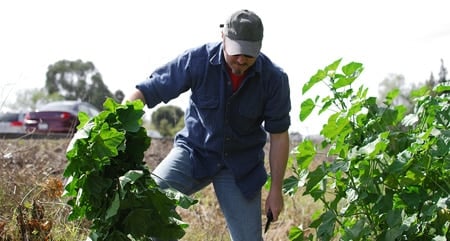
I think my advice would be that it is OK to use a little of these roadside plants, but don’t make a habit of it. If you can find them off the beaten path, go for broke.
Once we had the mallow home, I preserved the leaves for stuffing. You do this the same way you would preserve a grape leaf: Boil in salty water for a minute or two, shock in an ice water bath, let drip dry for a while, then roll up sideways and tie with string.
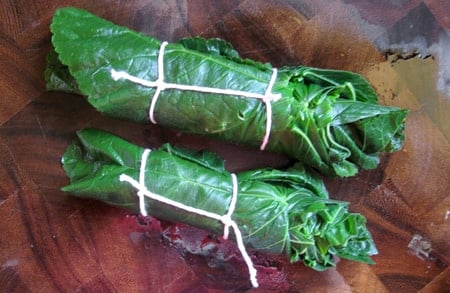
To preserve them, mix 1/4 cup of lemon juice, a splash of vinegar and a quart of water with 2 tablespoons salt and boil it. Stuff the wrapped leaves into a Mason jar and pour the hot mixture over them. Seal the jars and process in a boiling-water bath for 15 minutes. Or keep in the fridge.
What to stuff the mallow with? There are hundreds of dolma recipes on the web. Some “authentic,” some modern. Basically the only thing I can tell you is that you can use whatever the hell you want. My only caveat to such license is that if you use rice, you must use short- or medium-grained rice. Long-grained rice sets up hard when you eat it cold; it’s like eating twigs.
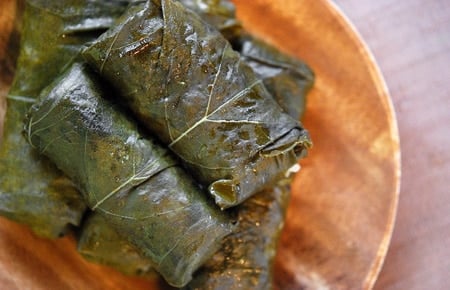
Stuffed Mallow Leaves
Ingredients
- 1 cup short or medium-grain rice
- 1/2 onion, minced
- 1/2 pound fresh mushrooms, minced
- Salt
- 1/3 cup pesto
- 3 tablespoons olive oil
- Grape or mallow leaves
Instructions
- Get a large frying pan hot over high heat. Add the mushrooms and shake the pan often until they release their water. When most of the water is gone, add the onion and the olive oil and a little salt. Toss to combine.
- Saute this over high heat until the onion begins to color, then add the rice. Toss to combine. Toast for a minute, then add 1 cup of water and a little salt. Turn the heat to medium and let the water cook away. When it is absorbed, turn off the heat and let the rice cool.
- Add the pesto and toss to combine. You can add a little olive oil if you have a dryish pesto.
- Grape and mallow leaves come in different sizes, so adjust the amount of filling as needed when you fill them. It should always be about a tablespoon, though.
- Line up your dolmas seam side down on a perforated vegetable steam insert, Chinese steamer or even on the bottom of a pan. Nestle them in snug against each other, and it is OK to stack them up to three levels high.
- Mallow leaves don’t need to be weighed down, but grape leaves benefit from it. Lay a plate over the dolmas when you put them in to the pot you are about to steam them in. I use a large stockpot.
- Put in enough water to come up just under the level of the dolmas, cover and bring to a boil. Steam gently for 40 minutes to an hour — why the difference? Depends on how fresh your rice is, and how much water it soaked up initially. Better to err on the long side than the short, as no one likes crunchy rice. Serve warm or at room temperature. Dolmas will keep for a week in the fridge.
Notes
Nutrition information is automatically calculated, so should only be used as an approximation.
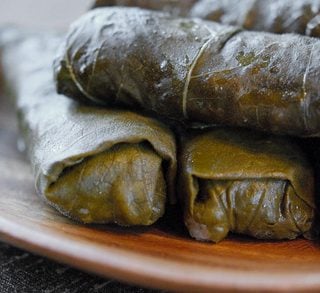

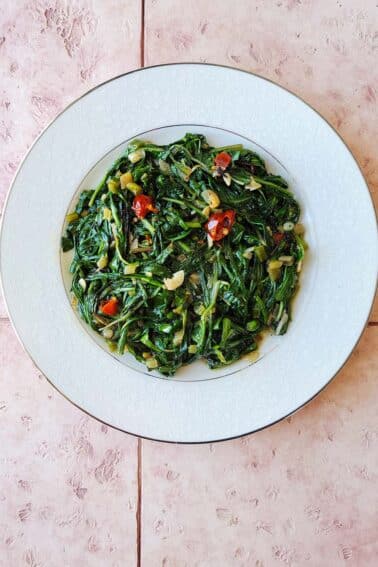
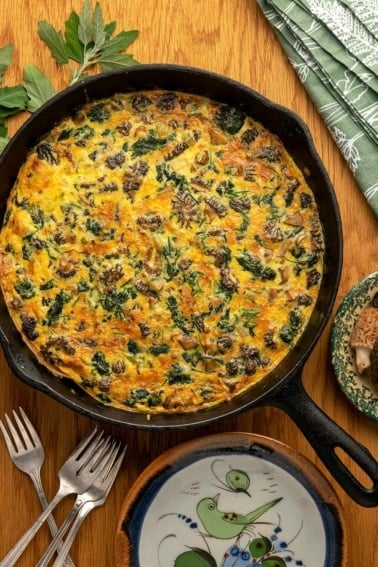
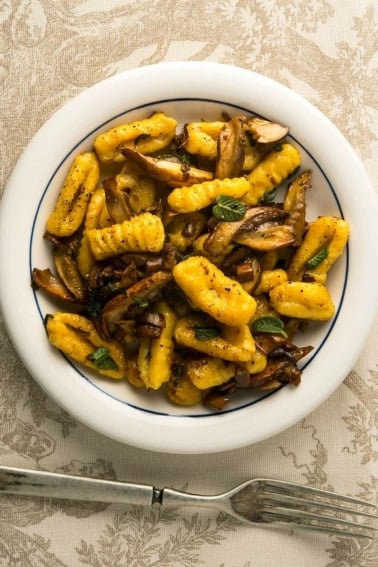
Car exhaust in roadside plants used to be a big danger with respects to heavy metals, but since tetraethyl lead was eliminated from gasoline in 1992 in California and 1996 in the whole US, exhaust is now metals-free. (TEL has never been used in diesel.)
That said, the immediate roadside is still a sketchy place for harvesting. Some roadsides are sprayed. Even those that aren’t accumulate all the runoff from the road surface–which includes oil, tars, and, more frightening by far, anything that might have been spilled on the road. In addition, all that lead from before the ban is often still in the soil–especially in drier regions of the country.
Ten or fifteen feet back from the road is a much safer environment. But no soil is really safe unless you know its history–including your own backyard!
I can’t believe I’ve just found this site after spending the day in the garden spraying you guessed it, Mallow! My yard (half acre) was filled with them some nearly as tall as me and I just hacked, slashed, and binned them for the green waste tomorrow and sprayed the remnants *head table*! Guess next year I’ll pull some up and replant them into a suitable area and go a preserving! Thanks for a really helpful page.
Hank. I know this is an old post, but your link to the seeds at Kitazawa take me to their page (https://www.kitazawaseed.com/seed_077-168.html) Molokhia or Corchorus olitorius. The Mallow you have pictured looks like malva verticillata. Are the pictures from the seeds?
The mallow I use is not the Kitazawa one, that’s a different plant entirely.
Hi. I just found your post on mallow and can’t wait to try using the leaves for dolmas. I do a lot of foraging in my urban backyard–I like to let weeds grow until I decide whether they are welcome or not. Last year, when we moved in, I let the mallow grow, not sure if it might be hollyhocks (clearly a relative). Once it bloomed, I was happy with the flowers, even though it was mallow rather than hollyhocks. This year I’ve got many more coming up, including some in my front yard which have turned out to look quite different from those in the back (paler, smaller flowers, smaller, more toothed leaves, and taller plants–about 8′). My plants in back have leaves that are 10-12 inches across.
I was going to attach photos, but don’t think I can attach to a comment. Down here in the Bay Area (I live in Richmond), the mallow is just beginning to bloom and will bloom through the summer. If you want, I can send you seeds from my large mallow plants. You can guerrilla plant them in some wild place where you would like to forage for them next year…
I look forward to reading more of your blog. Cheers,
Catalin
Fethiye: Welcome back! I know, if I find a stand of mallow in a quiet spot, I will let you know and we can pillage it next year.
I should have some sunchokes for you this winter. Check back with me…
Hey Hank! 😉 I am kind of back to blogging!!! Baby is about to be 2 years old, and now I kind of have more time…
I hate that mallows like the roadside! One more reason I have not had any when I was pregnant and breastfeeding. Just could not bring myself to do so.
Btw, I have just planted some sunchokes in our garden, and if, for some reason, they do not take off, I wanted to ask you for some… Is that ok? I know you had some coming out of your ears at some point! 😉
I enjoyed this post, although the season from mallows is over in Israel, as Mimi mentioned, the grape and mulberries are just coming out. I stuffed mulberry leaves with the usual rice and herbs with the addition of dried cherries which made an interesting addition. I don’t have Paula Wolfert’s grains book but do have Cooking of the Eastern Mediterranean which is wonderful. She has a few interesting Northern Greek pies in which she uses foraged greens.
Carol: Yep, the leaves would still be worth picking for dolmas, although they might be too tough for cooking otherwise. Nasturtiums are an aphid trap – a lot of gardeners plant them to lure aphids away from the rest of their gardens…
Giant mallow plants with huge leaves are still running rampant here in So. Calif.–though I don’t know if the leaves are still worth picking. Do they need to be younger leaves, Hank, or are mature leaves okay? The plants themselves have already gone to seed (someday I will try picking and cooking the immature fruits–they’re nice trail munchies when raw, and as they’re related to okra will probably be similar when cooked). I wanted to try stuffing nasturtium leaves, but I got a bad aphid infestation and had to cut my plants way back. Ah, well, they’ll grow back!
I just love this – I grew up eating Pazi Dolmasi (Mallow dolmas) and eating the mallow in boreks (like spanakopita) and such – I am half Turkish. In fact, I just spoke to my mom and told her about your post and she said she had coincidentally picked up a huge bundle of mallow at the pazar (outdoor market) earlier today! I haven’t made dolmas in AGES and I’m now having a big craving for them.
I have also had mallow in Egypt, I believe it was mallow anyway. It was called molokhaya and I know it is prepared in a variety of ways there but I had it in a broth based soup, where it was chopped quite finely. It was absolutely delicious! I need to figure out how to make that and if I do I will share. Oh, and get my hands on some mallow!
Thanks for the link to my mallows post, Hank. I was interested to see that mallows are in season where you are. Here in Israel, their best time has gone. The big, soft leaves have shrunk down as the plant’s energy goes into maintaining the long stems and roots.
Another thing to do with mallow leaves is to hang them up to dry, and store them in a cool dry place when all the moisture is out of them. Chuck them into any soup later on. Especially good in winter when leafy greens are scarce.
Now mulberries are coming into season – you can stuff mulberry leaves too.
Deanna: It is similar. The rose mallow is the small-leaved variety that’s good in a mixed greens saute. And I am pretty sure the big-leaved variety lives out East.
Julia: Yep, that’s the other variety that grows in hot weather. Confusing, I know.
Cathy: Wolfert rocks, and thank you on my dolma folding!
Kirsten: It is the ASFS listserv. And you never know, SoCal can be milder than NorCal. I’d go look around…
Joceyln: Using big nasturtium leaves is a GREAT idea! They are very peppery, though. I’d blanch them in salty boiling water for just a few seconds before rolling. They will be more pliable that way. As for the sea beans, glad to help!
Lang and Kevin: Yeah, I know. That’s why we looked so hard for them elsewhere. Like I said, it’s probably OK once in a while, but I sure don’t make a habit of it. Oh, and Kevin, I am sorry I had to strip out that URL, but there was some malware attached to it. I’ve been having security issues and you can’t be too careful.
I hate hackers.
I’m afraid I’m with Lang on this one.
Nice use of mallow, though be judicious with the roadside foraging. Highways, railroads, and telephone poles are pretty much toxic hotspots wherever you find them. Country lanes and logging roads are an issue because of herbicides used to keep the shoulders clear. I seem to remember a study that advised giving a 100 yard berth on either side of a highway. One of my best dandelion patches is near 1-5 and is now, unfortunately, off the list. The dilemmas of modern foraging!
That stuff was great! It sure helped lighten that Epic Fish&Forage trip we made.
Seriously, Hank, your dolmas look perfectly rolled. I made some tasty wild dolmas about a month ago using gigantic nasturtium leaves and a filling of tomatoey rice and sauteed dock. The dock was a perfect addition with its super savory, lemony flavor. It more than made up for the nasturtium leaves being fresh, not brined (though on that note, the nasturtiums also ended up being a revelation, with their peppery bite).
By the way, I love that you sometimes make it to my stomping grounds so I get to take advantage of your eagle eye. I knew exactly which pier in Bodega Bay you were referring to and happened to be there a few days later, so with just a tiny bit of searching I found that patch of sea beans that I probably never would have seen otherwise. Thanks!
Awesome post! SoCal mallow is probably gone by now if you’re seeing the last of yours. Too bad, I love dolmas and have been mourning the fact that I no longer live in Minnesota where wild grape twines up every telephone pole! Love the geeky food extras (what is that food listserv you’re on??)
Wow! This is such an inspiring post. I’m going to dig out my copy of the Wolfert book and see if any of the wild greens she writes about might have counterparts here in my garden.
I’m envious of your dolmada folding technique.
Hank: I wonder if this is similar to the rose mallow that grows like a weed in the NE.. a lovely weed but a weed and with smaller leaves. It has been used as a herbal remedy for country folk since… well forever. Never knew about eating it… that is very cool. I have worked with marshmallow and love hibiscus.. what an amazing family of plants! Thanks for the info.. I wonder if the plants grow in the east. I may have seen them and not known what they are.
I’ve never seen mallow grow, but I often buy the Jew’s Mallow (jute leaves) frozen at Arab markets. Alas, I couldn’t make dolmadas with this form. And it would seem that these leaves are much smaller than what you’ve found. I usually just stew it with chicken, onions and coriander (and lots of lemon) which is wonderful! https://www.growcookeat.com/2009/02/jute-leaves-moloukia.html